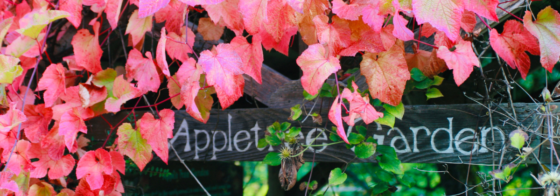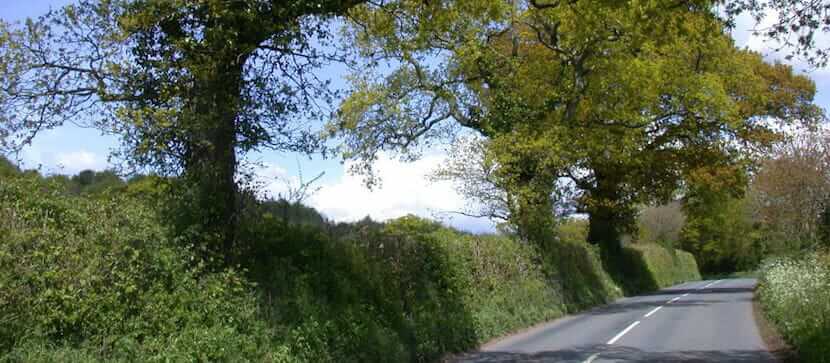 Those of you who have visited the Whidbey Institute recently may have noticed a mound of logs being laid around the parking lot at Thomas Berry Hall. What you are seeing is the construction of a hedgerow and restoration of the north-facing slope.
Those of you who have visited the Whidbey Institute recently may have noticed a mound of logs being laid around the parking lot at Thomas Berry Hall. What you are seeing is the construction of a hedgerow and restoration of the north-facing slope.
The completed hedgerow is intended to border the majority of the lot. It will create an ecologically rich boundary for the parking lot and aid in the restoration of the bramble-bothered north-facing slope. The slope is being cleared of brambles by digging them up by the roots, mulching the slope, and planting native plants.
There could have been many approaches to achieving the same thing, so I thought I would share how we came to the decision of a hedgerow. The truth is, we may not have if I had not lived in south west England for year.
After living in southwest England, this became my personal definition of a hedgerow:
Hedgerow: A snaking berm of exuberance that draws you into the symphony of the living world
Before living in England for a year, my understanding of a hedgerow was a dense line a shrubs, usually just one species, used mostly for privacy, where birds spend a lot of time. I think this is what comes to mind for most Americans.
In the southwest of England, hedgerows define thelandscape. They border most roads, sometimes so tall that you feel like you are in a tunnel. They border farmers’ fields, front yards, gardens, and just about everything needing a border.
 These hedgerows are made in many different ways, but all are given structure by woody plants like hawthorn, oak, and hazel. Sometimes the plants are “laid,” planted in a row and then bent over onto each other so that they form a sort of woven fence. Others are tall rock walls with massive oak roots binding it all together. Still others are gentle, low mounds of earth and rock that are covered in wildflowers and studded with coppiced hawthorn.
These hedgerows are made in many different ways, but all are given structure by woody plants like hawthorn, oak, and hazel. Sometimes the plants are “laid,” planted in a row and then bent over onto each other so that they form a sort of woven fence. Others are tall rock walls with massive oak roots binding it all together. Still others are gentle, low mounds of earth and rock that are covered in wildflowers and studded with coppiced hawthorn.
Because hedgerows act as borders, you often come into direct contact with them and can find yourself walking alongside of them for some distance. As a constant presence and one that is clearly manmade, hedgerows grab attention and begin to draw you into the world more than most landscape features.
Cacophonies of wildflowers coming in seasonal waves of erupting blossoms; quiet mosses collecting raindrops; the sound of critters skittering under the cover; the sound of birds quietly practicing their songs in the early spring and letting loose a month later; the thrum of bees . . .
I remember one night while walking home in the dark, I could hear rustling followed by a sharp crunch. The pattern kept repeating itself and I realized that just a few feet into the hedge was a badger poking around and crunching on snails.
So when I looked at the parking lot and thought about how to replace the brambles we constantly fight back with something else, I envisioned people arriving and stepping out of their vehicles into an area hugged by a beautiful hedgerow full of color, birdsong, and the rest.
 The questions were, did it make sense, and how would we make it?
The questions were, did it make sense, and how would we make it?
A hedgerow would help halt the blackberry before the lot and cast shade onto the north-facing slope that would discourage the blackberry from coming back after the slope was restored. It would provide a safer boundary than the existing fence, which cannot halt a car. It would create an extremely biodiverse border for the lot, providing cover, food, and nesting habitat for birds, small mammals, countless insects, pollinators, and so on. It would act as a suntrap, catching and storing the heat raining down from the southern sky onto the lot. This warmth would make a perfect microclimate if we wanted to plant fruit trees or berry shrubs along the top. Lastly, it would be beautiful, fragrant, and make the lot more welcoming and memorable while honoring the craft that went into building Thomas Berry Hall.
Next is the how. We do not have an abundance of earth or stone for mounding, but we do have an abundance of wood. Every year we remove far more more wood from trees fallen across paths and roads than we can store as firewood. Much of it goes to others who need firewood, but we still have a surplus.
Using the hugelkultur method to construct the foundation of the hedgerow would turn our surplus wood from a storage problem into a resource. Hugelkultur means “mound culture” in German and is a method of mounding woody material, covering it over with soil, and planting directly into it. Hugelkultur has become increasingly popular in the past few years, mainly through the permaculture community and its fascination with the curious (and brilliant) Austrian agrarian, Sepp Holzer, who has made extensive use of this method.
 The method has many applications from garden beds to hedgerows. The basic idea is that the wood decomposes over time, creating a spongy, nutrient rich mass that is great for plants. In places with dry summers, this spongy mass holds a tremendous amount of moisture and can reduce or eliminate the need for watering, depending on what and where you are growing.
The method has many applications from garden beds to hedgerows. The basic idea is that the wood decomposes over time, creating a spongy, nutrient rich mass that is great for plants. In places with dry summers, this spongy mass holds a tremendous amount of moisture and can reduce or eliminate the need for watering, depending on what and where you are growing.
We used big rounds of wood. These create an immediate, sturdy replacement for the the split rail fence and made it easy to build the mound up quite high. As the wood decomposes over the next few years, the mound will sink substantially leaving a mound that will likely be a bit higher than the knee.
On the north side of the mound you can see that burlap has been used to hold the topsoil and mulch in place and that sword ferns have been planted directly into the mound. The roots of the ferns will stabilize the soil the north-facing side of the mound. On the slope itself we have planted swordfern, vine maple, salal, and salmonberry, and we will continue to add species to restore habitat, stabilize the slope, and suppress the resurgence of the blackberry.
On the south-facing side of the mound that faces the parking lot, we will begin planting flowering herbs this spring. The rest of the design is yet to be decided. Trellised fruit trees? Berry shrubs? Medicinal plants? Native species? All of the above?
Please let us know if you have any thoughts, questions, or suggestions.


